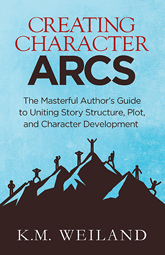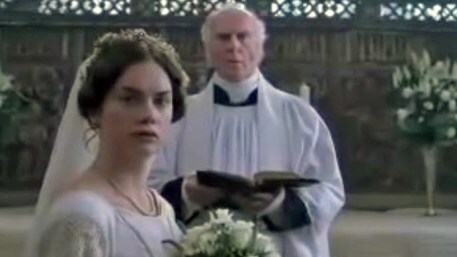The Two Halves of the Third Plot Point
 Like all the major structural turning points, the Third Plot Point is made up of two halves—which work together to create a scene arc (even though, technically, the entire arc of the beat might be told over the course of a scene sequence made up of many scenes). The halves that create this arc are important because only together can they create the realistic resonance of cause and effect. If the Third Plot Point is where the character sinks into a reverie on mortality (or at least the potential failure of his plot goal), there must first be a “high place” from which he falls. The higher this place, the more striking the plight of the Third Plot Point will be.
Like all the major structural turning points, the Third Plot Point is made up of two halves—which work together to create a scene arc (even though, technically, the entire arc of the beat might be told over the course of a scene sequence made up of many scenes). The halves that create this arc are important because only together can they create the realistic resonance of cause and effect. If the Third Plot Point is where the character sinks into a reverie on mortality (or at least the potential failure of his plot goal), there must first be a “high place” from which he falls. The higher this place, the more striking the plight of the Third Plot Point will be.
The Third Plot Point also signifies the “descent” into the following Climax. Regardless the character’s travails up to this point, everything is about to get much worse, at least in the sense that the conflict is finally coming to an irrevocable head. At the Third Plot Point, the protagonist descends into the abyss of the Third Act. This symbolic underworld could be as “heavy” as imprisonment and torture by the enemy or as “light” as nerves before a school dance recital. Whether or not the protagonist makes it out depends largely on how she copes with the two halves of the Third Plot Point.

Structuring Your Novel (Amazon affiliate link)
Once again, here’s a big-picture look at the beats we’re exploring:
Inciting EventFirst Plot PointMidpoint (or Second Plot Point)Third Plot PointClimactic MomentWhat Is the Third Plot Point?In many systems dealing with the Three-Act Structure, the Third Plot Point may also be called the Second Plot Point (in which case, the Midpoint is not considered a “major” plot point in its own right). Really, though, it’s just semantics; in both cases what is being referenced is the threshold between the Second and Third Acts, which takes place roughly 75% of the way into the story.

Creating Character Arcs (Amazon affiliate link)
This beat is a crucial transition point and should not be confused with the beginning of the Climax which takes place later on, halfway through the Third Act (at approximately the 88% mark). You may notice that in many stories—especially action-oriented movies—the Third Plot Point may be either skipped or its functional death/rebirth role is moved up to the preceding Second Pinch Point (taking place at approximately the 67% mark). This is usually done to create more story space for big set-piece climactic action scenes. But from a structural—and particularly a character-arc—perspective, it risks weakening one of the most important thematic beats in the entire story.
As we discussed last week, the Midpoint and its Moment of Truth is when the protagonist will accept the thematic Truth as true and begin trying to adopt it as a guide for his actions within the plot. However, the protagonist did not yet reject the Lie. For the remainder of the Second Half of the Second Act, the character will try to straddle both thematic paradigms or mindsets. And this is ultimately what brings him to the disaster of the Third Plot Point—and his final decision of whether he will fully “die” to the old Lie and be “reborn” in the new Truth. Depending on the nature of the story, this is a battle that may be waged down to the very depths of the character’s soul. It may even, literally, be a life and death decision.
The Third Plot Point will prove that the consequences for retaining the Lie are costly. But the beat itself will also force the protagonist to confront the reality that rejecting the Lie will also be costly. This is important. The temptation to keep the Lie instead of the Truth should be formidable. (Otherwise, why did it take the character 75% of the book to figure out that the Truth will clearly serve her much better?)
The Third Plot Point is also an important beat simply within the external conflict, since it sets up the Climax to come. In essence, the defeat at the Third Plot Point creates the final big obstacle between the protagonist and his plot goal. It is what creates the ultimate conflict between the protagonist and the antagonistic force in the Climax. Part of the “dark night of the soul” in the Third Plot Point is the question to the protagonist of whether or not he really wants the plot goal enough to tackle this final and most fearsome obstacle.
The answer, to one degree or another, will always be yes, since otherwise the story ends right there. This is true even if the character fails to choose properly between the Lie and the Truth. If she fails to utterly reject the Lie and be “reborn” into the Truth, she will proceed into the final conflict but with the wrong motives and/or tactics. She will either fail in her plot goal for lack of the Truth, or she will prevail but discover it is a hollow victory (or at least the audience will witness the harm it engenders for the rest of the story world).
>>Click here to read about the Negative Change Character Arc.
Recognizing the Arc Created by the Two Halves of the Third Plot PointThe Plot Revelation at the Midpoint gave the protagonist the ability to see the conflict more clearly and “take it to” the antagonist in a more proactive way. Even if the stakes are higher than ever in the Second Half, the protagonist at least now has a plan for reaching the plot goal. This section of the story will last from the Midpoint at the 50% mark all the way to the Third Plot Point at the 75% mark.
And then, all within the span of the two halves of the Third Plot Point, this course of action reaches what seems a dramatic victory—only to then plummet the protagonist into the worst fix yet (existentially if not physically).
The two halves of the Third Plot Point are the False Victory and the Low Moment.
The False VictoryThe False Victory is somewhat misnamed in that it very likely will be a true victory of some sort. Perhaps the protagonist attacks the enemy stronghold and gets what he wants, only to discover it was a trap or that his own army’s base was destroyed in his absence. It is a Pyrrhic victory.
For example, in Star Wars: A New Hope, Luke and his friends escape the Death Star—but with a tracking beacon aboard their ship that will lead the bad guys to the Alliance’s base.

In Jane Eyre, Jane is about to be married to her one true love—only to have the ceremony interrupted with news that he is already married.

What is important is that the protagonist either gains or seems to gain what she is trying for. The problem is that she is trying to push through to the end from a place that lacks total integrity. This lack of integrity doesn’t have to be strictly moral. It could simply be the result of not fully understanding what she’s doing, why, and what the ramifications will be.

Writing Your Story’s Theme (Amazon affiliate link)
From a thematic perspective, the victory turns out to be incomplete simply because the character is trying to “push it through” while being compromised in some way because she hasn’t fully rejected the Lie—and therefore can’t fully utilize the necessary Truth. It’s like trying to cheat to win a game of cards instead of doing it honestly through true skill.
Even if the False Victory is just a single moment in which the protagonist thinks he has triumphed, this emotional beat is important for setting up the fall into the subsequent Low Moment.
The Low MomentWhen we contemplate the Third Plot Point, the Low Moment is usually the part that comes to mind. Within the overall psychological arc of the story, the Third Plot Point always represents death. Intrinsically, this death is that of the Lie—and thus of the protagonist’s Lie-based paradigm and ability to identify with it.
However, externally within the plot, this death can be portrayed in many ways. This is very often where an important supporting character literally dies (such as Obi-Wan Kenobi in A New Hope).

But the death can also be that of an occupation or relationship (as in Jane Eyre).

It can also be represented simply via the threat of death to the protagonist herself. Or it might be glimpsed in a larger way via a world at war or even just careful symbolism in the background (e.g., ravens or black umbrellas).
It’s valuable to think of this beat as representing “death” both because of the thematic significance and also because “death” emphasizes the severity of this moment within the story. Even if what happens to the character here is not the “worst thing that could happen” (i.e., actual death), it is the worst thing that can happen in the context of the story up to this point.
It is a common misconception and source of confusion that the Third Plot Point must be the worst thing that happens in the entire story. What happens in the Climax may indeed be much worse: the protagonist may indeed die at that point. But whatever happens in the Climax will happen within the context of the protagonist’s new Truth-based perspective. So, for example, even if the character must sacrifice himself in the end, he will do so in the belief that his death is important and meaningful. In a Positive-Change (or Flat) Arc, he may die for the Truth. Symbolically, his soul will be at peace even if his body must be destroyed.
Of course, in many stories, this is portrayed much less dramatically. Actual death may not be part of the equation at all. Back to our dance-recital example, a young student may grapple at the Third Plot Point with fear of humiliation—aka ego death. If she rises from this struggle and carries on into the Climax with her dance routine, she will be thematically and existentially victorious whether or not she “wins” or “dies.”
But what if the character fails in his thematic grappling and refuses to “die” to the Lie? This failure at the Third Plot Point may well prove fatal in the final confrontation with the antagonistic force in the Climactic Moment. Or it may be that the character pushes through to his plot goal, only to find it an empty victory because he “gained the world but lost his soul.”
The external conflict will not be fully decided until the Climactic Moment. But the internal conflict will be largely resolved during the Third Plot Point and its subsequent scenes. The protagonist may not fully make up her mind (or realize she’s made up her mind) until the Climactic Moment. But whatever happens at the Third Plot Point determines whether or not the character “wins” her character arc and its internal thematic battle. The outcome of this beat is what provides context for the ultimate success or failure in reaching the plot goal in the following the Climax.
When both halves are utilized, the Third Plot Point has the potential to be one of the most moving and thought-provoking moments in any story. The key is creating the necessary emotional (and rational) shift from the high of the False Victory down into the depths of the Low Moment—and then, hopefully, back up again into a victory of true personal integrity.
***
Stay tuned: Next week, we’ll conclude our series by taking a look at the two halves of the Climax: Sacrifice and Victory/Failure.
Previous Posts in This Series:
The Two Halves of the Inciting EventThe Two Halves of the First Plot PointThe MidpointWordplayers, tell me your opinions! Can you identify both the False Victory and the Low Moment in your story? Tell me in the comments!Click the “Play” button to Listen to Audio Version (or subscribe to the Helping Writers Become Authors podcast in Apple Podcast or Amazon Music).
___
Love Helping Writers Become Authors? You can now become a patron. (Huge thanks to those of you who are already part of my Patreon family!)The post The Two Halves of the Third Plot Point appeared first on Helping Writers Become Authors.





